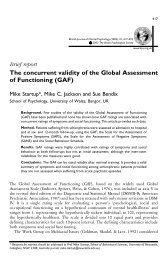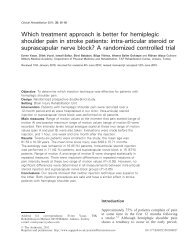Predictive validity of the Hendrich fall risk model II in an acute ...
Predictive validity of the Hendrich fall risk model II in an acute ...
Predictive validity of the Hendrich fall risk model II in an acute ...
Create successful ePaper yourself
Turn your PDF publications into a flip-book with our unique Google optimized e-Paper software.
A major strategy <strong>of</strong> <strong>the</strong> <strong>fall</strong> prevention programs<br />
supported by evidence has been <strong>the</strong> use <strong>of</strong> a <strong>fall</strong>-<strong>risk</strong><br />
assessment tool to identify patients highly at <strong>risk</strong> <strong>of</strong><br />
<strong>fall</strong><strong>in</strong>g on which to allocate <strong>the</strong> resources <strong>an</strong>d concentrate<br />
<strong>the</strong> healthcare efforts for prevention.<br />
Fall <strong>risk</strong> assessment tools have been <strong>in</strong>creas<strong>in</strong>gly<br />
developed <strong>in</strong> recent years, but most <strong>in</strong>struments have<br />
not been evaluated for reliability, <strong>validity</strong> <strong>an</strong>d cl<strong>in</strong>ical<br />
usefulness.<br />
The <strong>Hendrich</strong> <strong>fall</strong> <strong>risk</strong> <strong>model</strong> <strong>II</strong> (HFRM <strong>II</strong>) has shown to<br />
have good predictive values with sensitivity <strong>of</strong> 74.9% <strong>an</strong>d<br />
specificity <strong>of</strong> 73.9% <strong>in</strong> <strong>the</strong> pilot study. Also <strong>the</strong> <strong>fall</strong> <strong>risk</strong><br />
factors <strong>in</strong>cluded <strong>in</strong> <strong>the</strong> tool show a statistically signific<strong>an</strong>t<br />
correlation with <strong>fall</strong>s.<br />
What this paper adds<br />
The orig<strong>in</strong>al version <strong>of</strong> <strong>Hendrich</strong> <strong>fall</strong> <strong>risk</strong> <strong>model</strong> <strong>II</strong> was<br />
tr<strong>an</strong>slated <strong>in</strong>to Itali<strong>an</strong>.<br />
The reliability, <strong>validity</strong> <strong>an</strong>d cl<strong>in</strong>ical feasibility <strong>of</strong> HFRM <strong>II</strong><br />
were tested <strong>an</strong>d evaluated <strong>in</strong> <strong>an</strong> Itali<strong>an</strong> geriatric unit.<br />
Our study confirms previous research <strong>in</strong>dicat<strong>in</strong>g that <strong>the</strong><br />
HFRM <strong>II</strong> is a reliable <strong>an</strong>d valid tool to screen elderly<br />
<strong>in</strong>patients at <strong>risk</strong> <strong>of</strong> <strong>fall</strong><strong>in</strong>g.<br />
1. Introduction<br />
Falls are <strong>the</strong> most common adverse events reported <strong>in</strong><br />
<strong>acute</strong> care hospitals. Approximately 2–12% <strong>of</strong> patients<br />
experience at least one <strong>fall</strong> dur<strong>in</strong>g <strong>the</strong>ir hospital stay<br />
depend<strong>in</strong>g on ward type <strong>an</strong>d hospital sett<strong>in</strong>g <strong>an</strong>d population<br />
(Coussement et al., 2008). Literature report<strong>in</strong>g<br />
hospital <strong>fall</strong>s shows that older patients are <strong>the</strong> most likely<br />
to <strong>fall</strong> with great variability <strong>in</strong> <strong>the</strong> <strong>in</strong>cidence <strong>of</strong> <strong>fall</strong>s (2.2–<br />
17.1 <strong>fall</strong>s per 1000 patient days). In <strong>the</strong> elderly <strong>fall</strong>s c<strong>an</strong><br />
cause physical, psychological as well as social consequences.<br />
The most common physical consequences are<br />
bruises <strong>an</strong>d m<strong>in</strong>or <strong>in</strong>juries (28%), severe wounds <strong>of</strong> <strong>the</strong> s<strong>of</strong>t<br />
tissues (11.4%) <strong>an</strong>d bone fractures (5%) (K<strong>an</strong>nus et al.,<br />
2005). Moreover <strong>fall</strong>s may produce psychological <strong>an</strong>d<br />
social consequences such as <strong>an</strong>xiety, loss <strong>of</strong> confidence,<br />
impaired rehabilitation <strong>an</strong>d function, <strong>in</strong>creased costs for<br />
<strong>the</strong> healthcare system because <strong>of</strong> <strong>the</strong> prolonged patient<br />
stay <strong>an</strong>d <strong>of</strong> <strong>the</strong> treatments for <strong>the</strong> physical consequences<br />
(Rubenste<strong>in</strong> <strong>an</strong>d Josephson, 2001; Oliver et al., 2004).<br />
In addition, <strong>in</strong>patients <strong>fall</strong>s may result <strong>in</strong> feel<strong>in</strong>gs <strong>of</strong><br />
guilt <strong>an</strong>d <strong>an</strong>xiety for healthcare personnel, compla<strong>in</strong>t or<br />
litigation from patients’ relatives who feel that <strong>fall</strong>s are<br />
unacceptable <strong>in</strong> a sett<strong>in</strong>g that should be safe for <strong>the</strong>ir<br />
family members (Oliver, 2007).<br />
The <strong>risk</strong> <strong>of</strong> <strong>fall</strong><strong>in</strong>g c<strong>an</strong>not be completely elim<strong>in</strong>ated <strong>in</strong><br />
<strong>acute</strong> care sett<strong>in</strong>gs, but it c<strong>an</strong> be reduced through <strong>the</strong><br />
implementation <strong>of</strong> effective <strong>fall</strong> prevention programs<br />
(Gillespie et al., 2003; Rubenste<strong>in</strong>, 2006). A major strategy<br />
<strong>of</strong> <strong>the</strong> <strong>fall</strong> prevention programs supported by evidence has<br />
been <strong>the</strong> use <strong>of</strong> a <strong>fall</strong>-<strong>risk</strong> assessment tool to identify<br />
patients at high <strong>risk</strong> <strong>of</strong> <strong>fall</strong><strong>in</strong>g on which to allocate <strong>the</strong><br />
resources <strong>an</strong>d concentrate <strong>the</strong> healthcare personnel<br />
preventive efforts (Rubenste<strong>in</strong> <strong>an</strong>d Josephson, 2001;<br />
D. Ivziku et al. / International Journal <strong>of</strong> Nurs<strong>in</strong>g Studies 48 (2011) 468–474 469<br />
Gillespie et al., 2003). Such assessment tools typically<br />
consist <strong>of</strong> a rat<strong>in</strong>g or scor<strong>in</strong>g system designed to reflect <strong>the</strong><br />
cumulative effect <strong>of</strong> known <strong>risk</strong> factors (Scott et al., 2007).<br />
Several tools have been developed <strong>an</strong>d tested <strong>in</strong><br />
hospital sett<strong>in</strong>gs <strong>in</strong> <strong>the</strong> last years. Often <strong>the</strong> choice <strong>of</strong><br />
which is left to <strong>the</strong> nurs<strong>in</strong>g personnel who will use it <strong>in</strong> <strong>the</strong><br />
cl<strong>in</strong>ical practice. It is import<strong>an</strong>t that nurses select <strong>the</strong> most<br />
appropriate <strong>fall</strong>-<strong>risk</strong> assessment tool for <strong>the</strong> patients <strong>in</strong><br />
<strong>the</strong>ir sett<strong>in</strong>gs as <strong>the</strong> lack <strong>of</strong> accuracy <strong>of</strong> such tool c<strong>an</strong> lead to<br />
<strong>in</strong>appropriate distribution <strong>of</strong> <strong>fall</strong> prevention resources,<br />
contribut<strong>in</strong>g to failure <strong>of</strong> <strong>fall</strong> prevention programs (Oliver,<br />
2007; Perrell et al., 2001).<br />
Perrell et al. believe that <strong>the</strong> <strong>risk</strong> assessment tools<br />
should be selected on <strong>the</strong> basis <strong>of</strong> certa<strong>in</strong> criteria: have<br />
good psychometric properties (identify correctly high <strong>risk</strong><br />
population/true positive <strong>an</strong>d not at <strong>risk</strong> population-true<br />
negative), should be tested <strong>in</strong> a similar population <strong>in</strong> which<br />
it is <strong>in</strong>tended to be used, require not much time for <strong>the</strong><br />
adm<strong>in</strong>istration <strong>an</strong>d should have a cut<strong>of</strong>f score <strong>in</strong>dicat<strong>in</strong>g<br />
<strong>the</strong> need for <strong>in</strong>tervention (Perrell et al., 2001).<br />
A literature research on Medl<strong>in</strong>e <strong>an</strong>d CINHAL databases,<br />
us<strong>in</strong>g <strong>the</strong> search terms ‘‘accidental <strong>fall</strong>s, <strong>risk</strong> assessment,<br />
tools or scales, hospital or <strong>in</strong>patients, older adult <strong>an</strong>d<br />
validation study’’, has allowed <strong>the</strong> identification <strong>of</strong> 4<br />
literature reviews (Perrell et al., 2001; Myers, 2003; Oliver<br />
et al., 2004; Scott et al., 2007) which compared <strong>the</strong><br />
reliability <strong>an</strong>d <strong>validity</strong> <strong>of</strong> screen<strong>in</strong>g <strong>fall</strong> <strong>risk</strong> tools tested <strong>in</strong><br />
<strong>acute</strong> care sett<strong>in</strong>gs <strong>in</strong> order to assist cl<strong>in</strong>ical nurses <strong>in</strong><br />
select<strong>in</strong>g <strong>the</strong> most appropriate assessment tools for <strong>the</strong><br />
<strong>risk</strong> pr<strong>of</strong>ile on <strong>the</strong> <strong>in</strong>tended population.<br />
Perrell et al. recognized <strong>in</strong> <strong>the</strong>ir review 14 assessment<br />
tools tested <strong>in</strong> <strong>acute</strong> care sett<strong>in</strong>gs, but only two <strong>of</strong> <strong>the</strong>m, <strong>the</strong><br />
STRATIFY <strong>an</strong>d <strong>the</strong> Schmid, presented good sensitivity <strong>an</strong>d<br />
specificity values, however none <strong>of</strong> <strong>the</strong>m has been tested<br />
so far <strong>in</strong> o<strong>the</strong>r publications (Perrell et al., 2001).<br />
Likewise Myers, who <strong>an</strong>alyzed 47 articles published<br />
from 1981 to 2001 test<strong>in</strong>g more th<strong>an</strong> 30 different <strong>fall</strong>s <strong>risk</strong><br />
assessment tools, arrived to <strong>the</strong> conclusions that although<br />
m<strong>an</strong>y tools have been developed, few have undergone<br />
<strong>validity</strong> <strong>an</strong>d reliability test<strong>in</strong>g, <strong>an</strong>d even <strong>the</strong> most<br />
promis<strong>in</strong>g tools when tested by o<strong>the</strong>r researchers <strong>in</strong><br />
different cl<strong>in</strong>ical sett<strong>in</strong>gs showed a decreased <strong>in</strong> specificity<br />
(Myers, 2003).<br />
Oliver et al. <strong>in</strong> <strong>the</strong> exam<strong>in</strong>ed literature found only two<br />
<strong>risk</strong> assessment tools (Morse <strong>fall</strong> scale <strong>an</strong>d STRATIFY) that<br />
had undergone a rigorous prospective validation study<br />
(Oliver et al., 2004).<br />
Scott et al. came to <strong>the</strong> same conclusion that <strong>the</strong>re is no<br />
tool which c<strong>an</strong> be applied reliably across different sett<strong>in</strong>gs<br />
to predict <strong>risk</strong> <strong>of</strong> <strong>fall</strong><strong>in</strong>g <strong>in</strong> <strong>the</strong> elderly as <strong>the</strong>y have not been<br />
validated <strong>in</strong> more th<strong>an</strong> one sett<strong>in</strong>g <strong>an</strong>d have no strong<br />
predictive values <strong>an</strong>d recommend fur<strong>the</strong>r research to<br />
develop new valid <strong>an</strong>d reliable tools (Scott et al., 2007).<br />
It follows that at present <strong>the</strong>re are no valid <strong>an</strong>d reliable<br />
tools which c<strong>an</strong> be recommended <strong>in</strong> a hospital sett<strong>in</strong>g for<br />
elderly patients.<br />
Recently a new promis<strong>in</strong>g tool has been developed, <strong>the</strong><br />
<strong>Hendrich</strong> <strong>fall</strong> <strong>risk</strong> <strong>model</strong> <strong>II</strong> (HFRM <strong>II</strong>), a modified version <strong>of</strong><br />
a previous tool developed by <strong>the</strong> same author <strong>in</strong> 1995. It<br />
has been shown to have good predictive values with<br />
sensitivity <strong>of</strong> 74.9% <strong>an</strong>d specificity <strong>of</strong> 73.9% <strong>in</strong> <strong>the</strong>
















